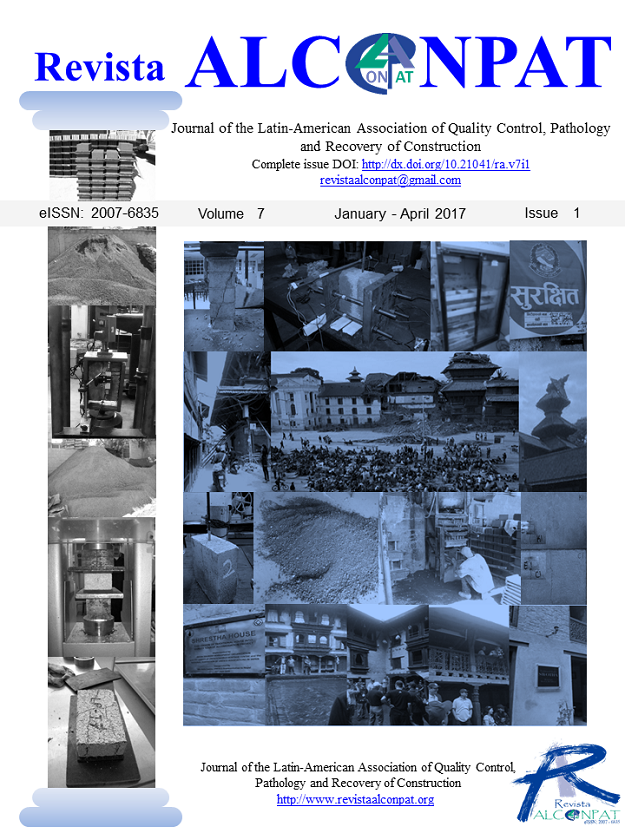Development of pseudo interface element for modelling of reinforced brick masonry
DOI:
https://doi.org/10.21041/ra.v7i1.147Keywords:
reinforced masonry joint, interface element, masonry reinforcement bond behavior, pseudo interface material, stiffness of interface elementsAbstract
Strength of reinforced masonry is influenced by interfaces between brick, mortar and reinforcement. Experimental protocol has been defined to characterise the behaviour of reinforced brick masonry joint, with reinforcement steel embedded in cement mortar 1:6. This is applicable for low-strength, low-stiffness brick masonry found. Experimental investigations show that bond between masonry and steel is not perfect. Considering critical bond mechanisms, an attempt is made to put-forth a novel approach for development of a pseudo interface element representing three different materials (viz. brick, mortar and reinforcement) and two interfaces (reinforcement-mortar (RM) interface and brick-mortar (BM) interface). Principles of classical Reinforced Concrete (RC) design can therefore be directly applied to reinforced masonry with the introduction of the proposed pseudo interface element.
Downloads
References
Arezoo Razavizadeh, Bahman Ghiassi, Daniel V Olieveira (2014), Bond behavior of SRG-strengthened masonry units: Testing and numerical modeling. Construction and Building Materials 64 (2014) 387–397 https://en.wikipedia.org/wiki/Flexural_modulus.
Gumaste K. S., Venkatarama Reddy B. V., Nanjunda Rao K. S., Jagadish K. S. (2004), Properties of burnt bricks and mortars in India. Masonry Int 17(2):45–52.
Hendry A. W. (1998), Structural masonry. Macmillan Press, London.
Van Noort J. R. (2012), Computational modelling of masonry structures, Delft University of Technology, Master Thesis.
Lenczner D. (1972), Elements of load bearing brickwork, Pergamon, Oxford.
Matthana M. H. S. (1996), Strength of brick masonry and masonry walls with openings. Ph D thesis, Department of Civil Engineering, Indian Institute of Science, Bangalore, India.
Narendra T. (2010), Design of masonry structures, 2nd Edition, International Code Council.
Lourenço P. B. (1994), Computational strategies for masonry structures, PhD Thesis, Faculdade de Engenharia da Universidade do Porto, Portugal.
Van Der Pluijm, R. (1992), Material properties of masonry and its components under tension and shear, in: Proc. 6th Canadian Masonry Symposium, eds. V.V. Neis, Saskatoon,Saskatchewan, Canada, p. 675-686.
Pluijm, R. Van Der (1993), Shear behavior of bed joints, in: Proc. 6th North American Masonry Conf., eds. A. A.
Hamid and Harris H. G. (1993), Drexel University, Philadelphia, Pennsylvania, USA, p. 125-136.
Raghunath S., Jagadish K. S. (1998), Strength and elasticity of bricks in India. Workshop on Recent Advances in Masonry Construction: WRAMC-98, Roorkee, India:141–150.
Sarangapani G., Venkatarama Reddy B. V., Jagadish K. S. (2005), Brick–mortar bond and masonry compressive strength. J Mater Civil Eng (ASCE) 17(2):229–237.
Mehendale S., Bambole A., Raghunath S. (2016), Studies on Pull-Out Resistance of Reinforcement in Bed-Joint of Brick Masonry, 10th International Conference on Structural Analysis of Historical Constructions –Anamnesis, diagnosis therapy, controls – Van Balen & Verstrynge (Eds) © 2016 Taylor & Francis Group, London, ISBN 978-1-138-02951-4, page 1093 - 1098
https://en.wikipedia.org/wiki/Stiffness
Is 1786: 2008, High strength deformed steel bars and wires for concrete reinforcement — Specification (Fourth Revision).
Published
How to Cite
Issue
Section
License
_______________________________
License in effect from September 2020
You are free to:
- Share — copy and redistribute the material in any medium or format for any purpose, even commercially.
- Adapt — remix, transform, and build upon the material for any purpose, even commercially.
- The licensor cannot revoke these freedoms as long as you follow the license terms.
Under the following terms:
- Attribution — You must give appropriate credit , provide a link to the license, and indicate if changes were made . You may do so in any reasonable manner, but not in any way that suggests the licensor endorses you or your use.
- No additional restrictions — You may not apply legal terms or technological measures that legally restrict others from doing anything the license permits.
Notices:
You do not have to comply with the license for elements of the material in the public domain or where your use is permitted by an applicable exception or limitation .
No warranties are given. The license may not give you all of the permissions necessary for your intended use. For example, other rights such as publicity, privacy, or moral rights may limit how you use the material.





















.png)














